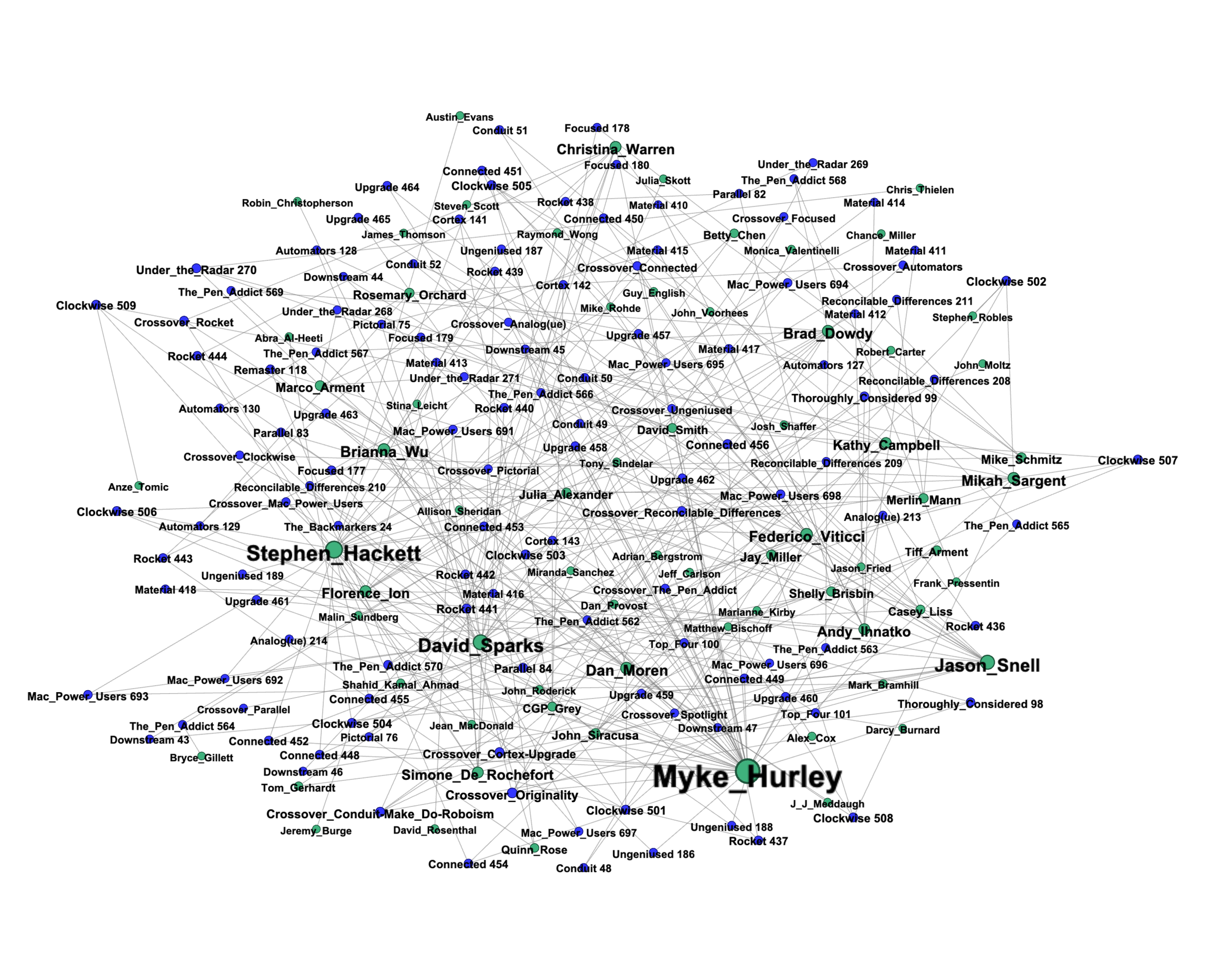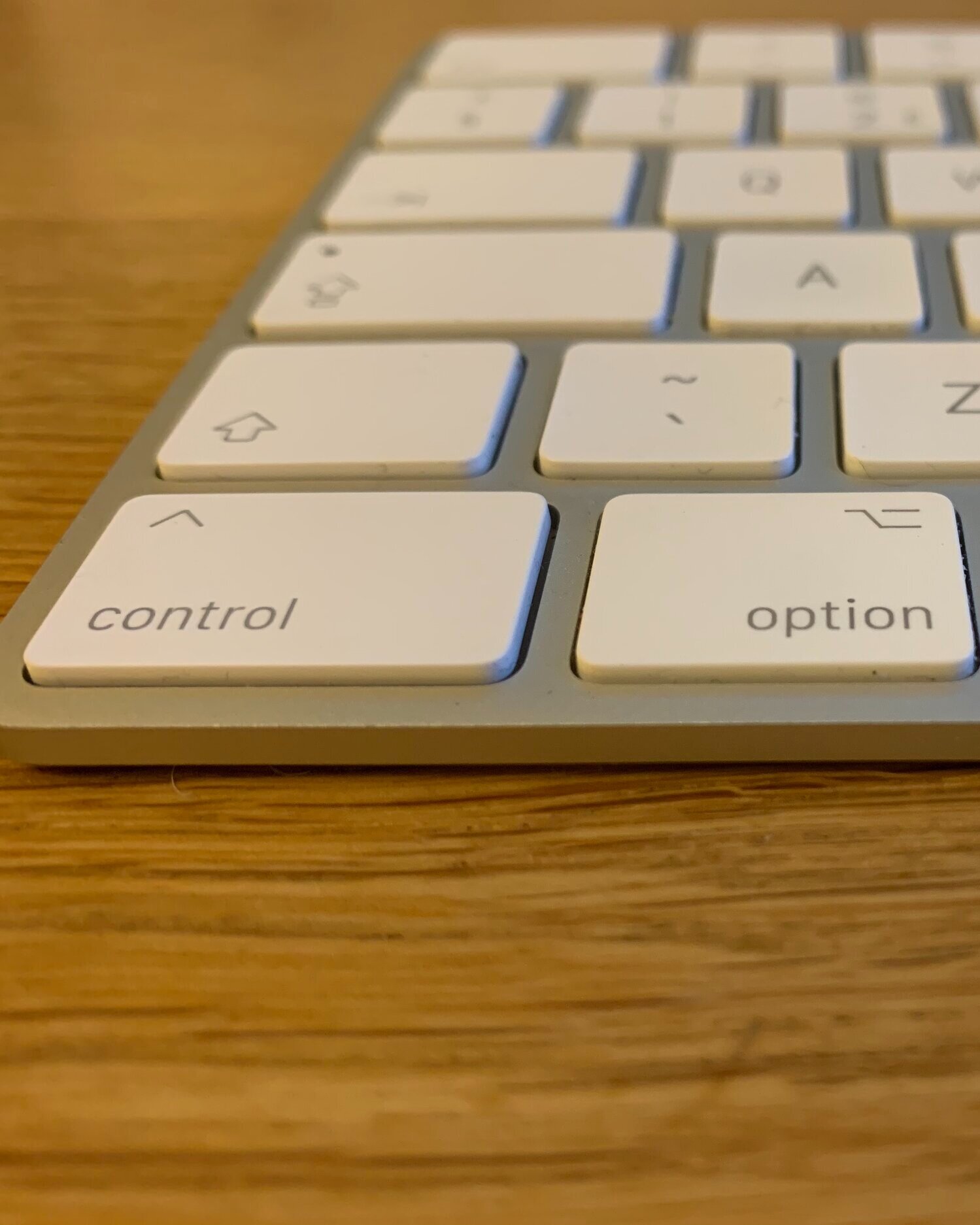The Relay FM social network graph (May-June 2023)
Relay FM is an independent podcast network, with a variety of different podcasts either still in production or retired. Their focus is primarily on technology, Apple, creativity, and ultimately building a community of hosts and listeners. Several of the hosts appear on multiple podcasts on a regular basis, and feature as guests on each others’ shows, while other people contribute to one or more shows on an intermittent basis, without having a regular home.
I wanted to see what it could look like to represent Relay FM’s podcast output using social network analysis. This is my first result:
Fig. 1: Relay FM podcast network, containing individual podcast episodes, their hosts and guests, in a random arrangement.
Some notes on Fig. 1:
This graph contains both people (green circles) and podcast episodes (blue circles). In social network analysis (SNA) terms, this is a “two mode network”. People are connected to podcasts, and podcasts are connected to people. There are no direct connections between people, nor between podcasts.
The time period covered is May and June 2023. This covered several weeks of regular output, as well as the annual “Members’ Specials” episodes. These months also included the build-up and immediate analysis of Apple’s WWDC event in early June, which is a busy time for the network.
The data came from publicly available sources. Most importantly this “Relay FM All-Network Feed" archive on the Podchaser site. This was the best source I could find to retrospectively access a record of the (freely) publicly available output from the network. (I also tried the all-network feed in various podcast players, but the available list of episodes didn’t go back particularly far.) I supplemented these freely available episodes with others from the Relay FM “Crossover” feed: Crossover is only available to members, and it hosts all episodes of the Members’ Specials, Backstage and Spotlight podcasts.
The graph contains:
69 people (green nodes)
124 podcast episodes (blue nodes)
308 connections (black edges)
You can see in the graph that some green nodes are bigger than others, and their name labels are proportionately bigger as well. Node size is representing the “degree” of each node: how many connections each node has. People who appeared on more podcasts have bigger names: Myke Hurley and Stephen Hackett are particularly prominent (they are also the co-founders of the network). Also notable are David Sparks, Christina Warren, Kathy Campbell, Jason Snell, Mikah Sargent, Federico Viticci and a few others. Please keep in mind that each podcast episode is being included here, so a weekly show will have twice as many entries as a fortnightly one, with a knock-on effect on the network degree of the people involved.
The SNA software used for this is Gephi. It is free, and cross-platform. I used it for my PhD on festival social networks, but haven’t done any practical SNA for a while and need to keep my skills fresh!
Here is a development of the network graph:
Fig. 2: Relay FM podcast network, containing individual podcast episodes, their hosts and guests, showing a clearer overall structure, and three distinct parts to the network.
In Fig. 2, the nodes have been arranged in a much clearer fashion. It is possible to extract quite a lot more information:
There are three distinct sub-sections: a large main body of the network, containing both offshoots and also clusters of relatively dense connections; and two much smaller parts of the network that are not connected to the main component.
It is easy to imagine how some small variations in the data would have altered this overall structure. For example, Brianna Wu is a host of the Rocket podcast, whose community of hosts would be separated from the main component if she had not also appeared on a single episode of the Clockwise podcast. Her Clockwise connection means that everyone else involved in the Rocket podcast is also connected to the main component of the network. Had something similar happened to the Pictorial or Reconcilable Differences podcasts, then they too would be connected up with everyone else.
As in the first graph bigger names mean more podcast appearances, and it is now possible to get some sense of that. Looking at the gap between Myke and Stephen, it is much clearer that they share a number of appearances through the Connected and Ungeniused podcasts. Stephen is also connected to David Sparks through Mac Power Users, who in turn is connected to Mike Schmitz (Focused) and Rosemary Orchard (Automators).
Clockwise is a really important podcast for linking parts of the Relay FM network. It has two regular hosts (Dan Moren and Mikah Sargent), who are not particularly prominent here in terms of degree alone. But their podcast features two guests each week, often drawing from hosts of other podcasts, and thus is a high profile glue holding together different parts of the network. Clockwise also welcomes a number of people who do not have another home at Relay FM, and is therefore an effective way for the network to reach beyond its regular hosts.
This last point is definitely worth noting. Relay FM is a relatively large collection of podcasts, but it exists within a wider ecosystem. A potential future development of this project could include podcasts that are not under the Relay umbrella, such as: Accidental Tech Podcast, The Talk Show with John Gruber, Robot or Not, the AppleInsider Podcast, MacBreak Weekly, AppStories, iOS Today, The Rebound, Ruminate Podcast and more. Data from May and June 2023 have connected all of these non-Relay podcasts to this network, and would have shown an increasingly complex and rich ecosystem.
Here is Figure 3:
Fig. 3: Relay FM podcast network, with episodes of each podcast merged, then linked to their hosts and guests, in a random arrangement.
In Fig. 3 we are back to the random arrangement, but for this graph multiple episodes of each podcast have been merged. There is only one Connected on the graph (representing multiple episodes), one Clockwise, one Under the Radar, and so on.
Darker lines reflect multiple episodes being represented on the same connection: three episodes of Cortex, linking Myke Hurley and CGP Grey, for example.
Lighter lines reflect a single connection: a one-off guest on a single episode, for example.
This graph shows that I have not included the Members’ Specials when merging nodes. This is partly because some of them span two or more different podcasts (such as Conduit, Make Do, and Roboism). I also wanted to give some sense of the scale and contribution of the Members Specials, in comparison to the regular output from the network.
Finally, here is Figure 4:
Fig. 4: Relay FM podcast network, showing podcasts (with episodes merged), Members’ Specials, their hosts and guests.
Figure 4 is focused on the main component of the overall network (as noted above, in relation to Fig. 2). There is quite a bit to note here:
Myke Hurley is surrounded by podcasts. He appeared on more episodes than anyone else, and across a larger quantity of different titles: Connected, Cortex, The Pen Addict, etc. In addition, most of them had a Members’ Special episode.
Clockwise, meanwhile, is surrounded by people. A lot of the guests on Clockwise only feature on the graph because of their appearance on this show. But some, as noted, are acting as bridges to other parts of the network: Shelly Brisbin, Brianna Wu, Jay Miller and Kathy Campbell are notable for this.
This graph, as with all of the others, is lacking in refinement and detail in places. There is no accounting for the size of audience that a podcast might have, either for individual episodes or when the episodes are merged. Nor is there any accounting for the duration of each episode, nor for the age and longevity of each podcast.
This analysis has focused purely on the graphs created by Gephi, and has ignored the many calculations and statistics that could be drawn from the available data. There are various ways to calculate how “central” someone is within a network, for example. (See Wikipedia on “centrality”.) It is also common to see two-mode networks be converted to one-mode networks: for the Relay FM network, this would mean establishing connections directly between people (or podcasts), in order to learn more about these interpersonal connections. Doing so might reveal new insights into the network’s structure, such as the potential for a “core-periphery” structure, or distinct clusters and cliques within the overall network.
Relay FM is a well-established podcast network, that supports its hosts, and builds communities with its listeners. There is a lively online community forum through the members’ Discord platform, for example. There is a considerable amount of activity each and every week, from the regular episodes and specials, to the opportunities for merchandise sales, and the exceptional annual fundraising drive for the St Jude Children’s Research Hospital. For the listener, there is a lot to engage with, and lots of interconnections between episodes and between podcasts. And, as noted, these connections extend beyond Relay FM, taking in a range of other podcasts. It is a rewarding environment, that repays regular engagement.
In closing though, on a personal note, I don’t know anyone else who listens to any of these podcasts. I’m definitely an outlier in the Relay FM network! It is interesting to reflect on the psychology of feeling part of a community yet not having anyone to enjoy and discuss it with. While it is seemingly well known among podcasters that they have a particularly intimate relationship with their listeners (speaking directly to them on the morning commute, or while exercising, or providing a soundtrack as people fall asleep), I do wonder how this is affected by the presence of a network of podcasts. It suggests aspects of a common culture, with similar topics of conversation spanning different hosts and episodes, and aspects of a shared language. This might have some echoes in traditional radio stations, which listeners have long held a sense of connection to. Yet within this podcast network there is more going on: listeners are encouraged to write in with follow-up on the themes of each episode, while the hosts also engage with their audiences through the week on social media. That brings a level of connection between hosts and listeners that can be so captivating: a host reads out a comment from a listener, which generates discussion between the co-hosts; one of those hosts then appears as a guest on another podcast; the host of the second podcast has recently interviewed the top executives of Apple, or whoever; meanwhile the listener is privy to all this, and feels a part of it. These connections help to validate the listener’s interest and investment in a particular topic. I’m sure Myke, Stephen and others in the Relay FM network would point to their Discord server conversations as a natural home for listeners to connect with each other, and the hosts, on an ongoing basis. I should log in more often!
So, Relay FM, keep doing what you do, and we’ll keep listening, building connections and supporting the network.








